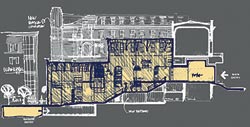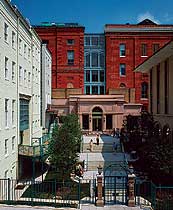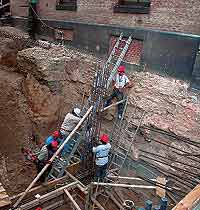Giving Old Buildings a Reason to Live
The Peabody Institute
Founded in 1857 in Baltimore, the Peabody Institute established a premier cultural resource-the country's first conservatory of music, the city's first publicly accessible library, an art collection, and a scientific society-within the now historic Mount Vernon district. The monumental, Italianate building--with a double-height performance hall on first level and a double-height gallery on the second--was designed by architect Edmund Lind in 1857 and built in 1861. A second building, also designed by Lind to attach seamlessly to the first via a shared central entry and marble-clad front facade, was erected in 1875 to provide a separate lecture hall for the society at the lower level and more fitting spaces for the library at the upper levels.
As the private institution flourished, its facilities expanded across the city block. An academic building for the music school-called Leakin Hall--was built in the 1920s. In the 1960s, perhaps influenced by the urban strife of that period, architect Edward Durrell Stone envisioned a block-wide campus for the growing institution that would focus on an internal outdoor plaza. Stone also designed a dormitory with underground garage, which was built around this time. Another structure-known simply as the New Academic Building-was added to Leakin Hall in the 1980s, a few years after the institute became part of Johns Hopkins University. And in the 1990s, a row of 19th-century structures was acquired to provide additional academic and administrative space plus guest rooms for the Institute's very active Elderhostel program.
|
Unfortunately, by the end of the 20th-century, the complex had become a fortress to enter and a virtual maze to navigate. Pedestrians had to enter through gates adjacent to a guard house at a side entrance off Washington Place, as the original front door along Mount Vernon Place remained permanently locked; guests parking in the garage had to wind their way through dismal basement corridors, following signs pointing them to the main entrance; and students had to drag valuable instruments outside, and up and down stairs, to get from one part of the complex to another.
The renovation by Quinn Evans Architects of Washington, DC, completed last year, put an end to all that. The design firm opened up the campus to the outside and improved internal circulation, all the while creating much needed programming space in a cherished historic building on a tight urban site. Needless to say, all of these moves required careful attention to structure and systems. Robert Silman Associates of New York served as structural engineer and Vanderweil Engineers of Alexandria, Virginia, oversaw the modernization of mechanical, electrical, and plumbing systems.
To begin to solve the campus's most vexing circulation problems, the architects inserted a new, 5,000-square-foot arcade into the outdoor light well between the two Lind buildings. The glass-covered arcade now serves as a formal lobby for the performance spaces. "For the first time, concert-goers can buy tickets, check coats, access restrooms, and spend intermission in an environment that enhances their experience," says design architect Michael Quinn, FAIA.













